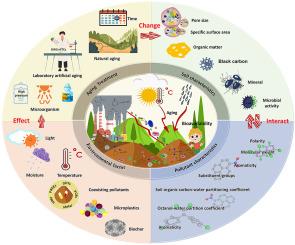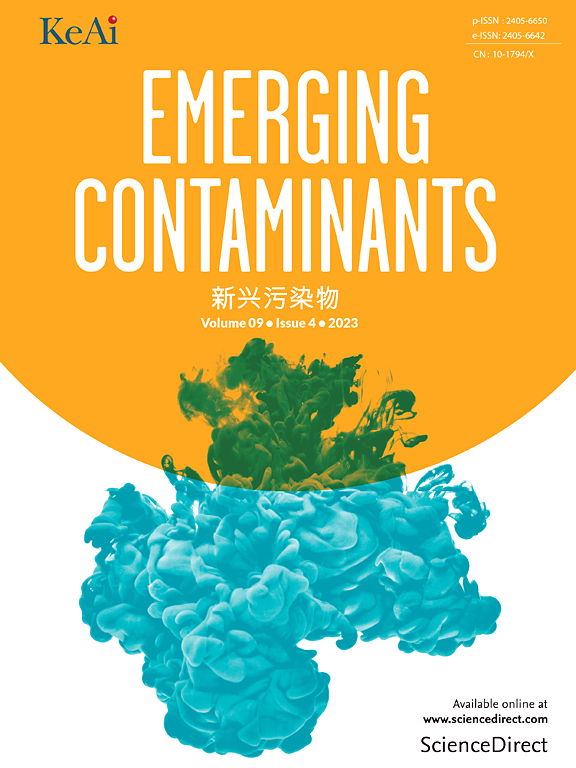HOCs生物有效性对土壤老化的响应:关注老化条件、环境因素和载体介导的土壤性质变化的间接影响
IF 6.9
2区 环境科学与生态学
Q1 ENVIRONMENTAL SCIENCES
引用次数: 0
摘要
疏水有机污染物(hoc)在土壤中的积累是一个全球性问题,其进入土壤后随时间变化的界面行为直接决定了hoc的生物有效性,已引起人们的广泛关注。尽管在过去的几十年里,关于老化与土壤中HOCs残留之间的关系已经发表了大量的综述,但关于老化对HOCs生物有效性的影响仍然缺乏一套描述性的描述。综述了全球土壤中典型hoc的存在浓度及其在土壤中的老化机制。考虑到生物利用度的重要性,进一步分析了各种因素(老化条件、环境因素、载体、土壤特征和污染物性质)对HOCs生物利用度和风险评价的影响。其中,将外界因素介导的土壤性质变化与土壤中有机碳生物有效性随时间的变化联系起来是主要亮点。今后的研究重点应集中在:(1)土壤微界面对老化过程的动态响应及其与老化过程中有机碳生物有效性变化的关系。(2)强化老化(冻融循环和干湿循环)与恒温恒湿老化、自然老化与人工老化在土壤中HOCs吸附、解吸行为和生物利用度的差异。(3)在多种污染物和环境载体(生物炭和微塑料)存在的情况下,老化对土壤中HOCs的环境行为和生物有效性的影响,特别是同步老化(土壤内的载体老化)而不是预老化。本文章由计算机程序翻译,如有差异,请以英文原文为准。

HOCs bioavailability response to soil aging: Focusing on the indirect effects of aging conditions, environmental factors, and carrier-mediated changes in soil properties - A review
The accumulation of hydrophobic organic contaminants (HOCs) in soil is a global problem, and the time-dependent interface behavior after entering the soil directly determines the HOCs bioavailability, which has attracted much attention. Despite a significant volume of reviews on the relationship between aging and HOCs residues in soil have been published in the past few decades, whereas a set of descriptive about the effects of aging on HOCs bioavailability are still lacking. We summarizes the occurrence concentration of typical HOCs in global soil and its aging mechanism in soil. Considering the importance of bioavailability, the influence of various factors (aging conditions, environmental factors, carriers, soil characteristics and pollutant properties) on the HOCs bioavailability and risk assessment were further analyzed. Among them, linking the alternations in soil properties mediated by external factors with the changes in the bioavailability of HOCs in soil over time is the main highlight. We suggest that future research should focus on: (1) the dynamic response of soil micro-interfaces to aging processes and their relationship with the variations of HOCs bioavailability during aging. (2) the differences in adsorption, desorption behavior and bioavailability of HOCs in soils between enhanced aging (freeze-thaw cycles and dry-wet cycles) and constant temperature and humidity aging, and between natural and artificial aging. (3) the effects of aging on the environmental behavior and bioavailability of HOCs in soils in the presence of multiple contaminants and environmental carriers (biochar and microplastics), especially the synchronous aging (carriers aging within the soil) rather than the pre-aging.
求助全文
通过发布文献求助,成功后即可免费获取论文全文。
去求助
来源期刊

Emerging Contaminants
Medicine-Public Health, Environmental and Occupational Health
CiteScore
10.00
自引率
6.70%
发文量
35
审稿时长
44 days
期刊介绍:
Emerging Contaminants is an outlet for world-leading research addressing problems associated with environmental contamination caused by emerging contaminants and their solutions. Emerging contaminants are defined as chemicals that are not currently (or have been only recently) regulated and about which there exist concerns regarding their impact on human or ecological health. Examples of emerging contaminants include disinfection by-products, pharmaceutical and personal care products, persistent organic chemicals, and mercury etc. as well as their degradation products. We encourage papers addressing science that facilitates greater understanding of the nature, extent, and impacts of the presence of emerging contaminants in the environment; technology that exploits original principles to reduce and control their environmental presence; as well as the development, implementation and efficacy of national and international policies to protect human health and the environment from emerging contaminants.
 求助内容:
求助内容: 应助结果提醒方式:
应助结果提醒方式:


